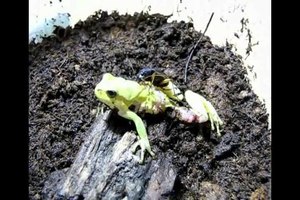Epomis
| Epomis | ||||||||||||
|---|---|---|---|---|---|---|---|---|---|---|---|---|

Epomis dejeani eats a southern banded newt |
||||||||||||
| Systematics | ||||||||||||
|
||||||||||||
| Scientific name | ||||||||||||
| Epomis | ||||||||||||
| Bonelli , 1810 |
Epomis is a genus of ground beetles (Carabidae). It belongs to the subfamily Harpalinae to the tribe Chlaeniini (synonym: Callistini), which mainly includes species living in swamps and other wet habitats. Many taxonomists consider Epomis only a subgenus of the genus Chlaenius . The genus includes around 20 to 30 species worldwide, two of which are found in Europe.
features
The species of the genus are colored black or more often metallic blue or green, with a conspicuous yellow border and mostly yellow-colored legs and antennae. They differ from the related genera by the short (less than three times as long as wide) and triangular widened labial palps as well as by the antennae, the third member of which is much longer than the fourth.
The larvae reach a body length of up to approx. 20 millimeters, they are colored yellow with black markings or black. Like many carabid larvae, they are elongated with protruding long mandibles and two appendages (urogomphi) at the rear end. The two European species can be distinguished according to the pattern of the drawing.
Way of life
The adults as well as the larvae mostly live in the bank zone of waters.
The larvae and adults of the species Epomis circumscriptus and Epomis dejeani hunt frogs and other amphibians in a rare reversal of the usual predator-prey ratio. The insect initially behaves like a prey, but when a frog tries to eat it bites into it and sucks it out. If the protruding tongue could not be avoided and the insect is swallowed, it is usually quickly regurgitated. In one case of a larva that had already been eaten, this only happened after two hours. Even after this period of time, the frog was eaten, albeit with a little tutoring from the researchers. The adults also kill amphibians and feed on them.
The adults sneak up on their victims, freshly metamorphosed young frogs, and bite their backs with their mandibles. The frog tries to escape by jumping or to shake off the predator, mostly in vain. After a cut in the pelvic region, the victim loses his mobility and is eaten up to the head and extremities within one to one and a half hours.
The East Asian species Epomis nigricans has also been reported to feed on amphibians at least occasionally.
distribution
The genus has its distribution center in Africa south of the Sahara, in addition, some species occur in East Asia to Japan. Five species live in the Western Palearctic . The two species Epomis circumscriptus and Epomis dejeani reach Europe from the southeast. The northern limit of distribution is for E. dejeani in the Hungarian Danube plain and for E. circumscriptus in northern Italy and southern France. The species are rare in Europe. Epomis circumscriptus is believed to be threatened with extinction in Italy.
Web links
- An Epomis species attacks and eats a juvenile frog Video on Youtube.com
- Insect eats frog , article on zeit.de
Individual evidence
- ↑ Pietro Brandmayr, Teresa Bonacci, Tullia Zetto Brandmayr (2010): Larval morphology of Epomis circumscriptus (Duftschmid 1812) and of first instar E. dejeani, Dejean, 1831, (Coleoptera, Carabidae, Chlaeniini), with morphofunctional remarks. Zootaxa 2388: 49-58.
- ↑ Subgenus Epomis in: Carabidae of the world ( page no longer available , search in web archives ) Info: The link was automatically marked as defective. Please check the link according to the instructions and then remove this notice.
- ↑ Karel Hurka (1996): Carabidae of the Czech and Slovak Republics. (Kabourek) ISBN 80-901466-2-7
- ↑ Gil Wizen & Avital Gasith (2011): Color variability and body size of larvae of two Epomis species (Coleoptera, Carabidae) in Israel, with a key to the larval stages. ZooKeys 119: pp. 37-52. doi : 10.3897 / zookeys.119.1451
- ↑ Wizen G, Gasith A (2011): An Unprecedented Role Reversal: Ground Beetle Larvae (Coleoptera: Carabidae) Lure Amphibians and Prey upon Them. PLoS ONE 6 (9): e25161. doi : 10.1371 / journal.pone.0025161
- ↑ a b Gil Wizen & Avital Gasith (2011): Predation of amphibians by carabid beetles of the genus Epomis found in the central coastal plain of Israel. ZooKeys 100: pp. 181-191. doi : 10.3897 / zookeys.100.1526
- ^ Pietro Brandmayr & Maria Carmela Algieri (2010): Habitat affinities of Chlaeniine species (Coleoptera: Carabidae) in Calabria and the status of Epomius circumscriptus, evaluated by the "Cronogeonemie" software. In: P. Brandmayr et al. (editors): Natural history and applied ecology of carabid beetles: 71-78.
